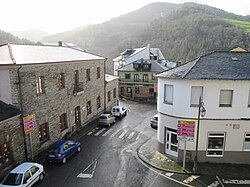
Sierra Nevada is a mountain range in the Andalusian province of Granada in Spain. It contains the highest point of continental Spain: Mulhacén, at 3,479 metres (11,414 ft) above sea level.

The Sierra Nevada de Santa Marta is an isolated mountain range in northern Colombia, separate from the Andes range that runs through the north of the country. Reaching an elevation of 5,700 m (18,700 ft) just 42 km (26 mi) from the Caribbean coast, the Sierra Nevada is the highest coastal range in the tropics, and one of the highest coastal ranges in the world, being 250 metres (820 ft) shorter than the Saint Elias Mountains in Canada. The Sierra Nevada encompasses about 17,000 km2 (6,600 sq mi) and serves as the source of 36 rivers. The range is in the Departments of Magdalena, Cesar and La Guajira.

Castropol is a municipality in Asturias, Spain. It is also the name of a parish within the municipality and a town within the parish.

Castroverde is a municipality in the province of Lugo, in the autonomous community of Galicia, Spain. It belongs to the comarca of Lugo.

The Minho or Miño is the longest river in Galicia, with a length of 340 kilometres (210 mi). It forms part of the international border between Spain and Portugal. By discharge volume, it is the fourth largest river of the Iberian peninsula after the Douro, Ebro, and Tagus rivers.
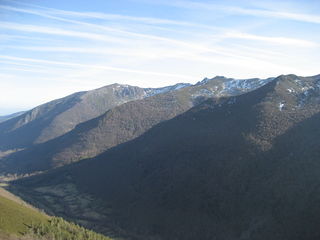
The Serra dos Ancares is a mountain range of the Galician Massif in north-west Spain, extending in a south-westerly direction from the western end of the Cantabrian Mountains in Asturias.

Vegadeo is a municipality in the Autonomous Community of the Principality of Asturias, Spain. It is bordered in the north and east by Castropol, in the south by Villanueva de Oscos, Taramundi, and San Tirso de Abres, and in the west by the Eo River and San Tirso.

San Tirso de Abres is a municipality in the Autonomous Community of the Principality of Asturias, Spain. It is bordered on the north, south, and west by Lugo province of Galicia, and on the east by the municipalities of Taramundi and Vegadeo. It is the westernmost council in Asturias.
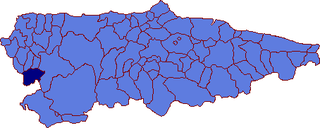
Grandas de Salime is a municipality in the Autonomous Community of the Principality of Asturias, Spain. It is famous for its hydroelectric dam across the Navia River, forming the Embalse de Salime. It is also famous for being a stop along the Camino Primitivo path of the Camino de Santiago, where it is the last stretch of Asturian land before the entrance into Galicia through the Acebo Pass.

Galician–Asturian or Eonavian is a set of Romance dialects or falas whose linguistic dominion extends into the zone of Asturias between the Eo River and Navia River. The dialects have been variously classified as the northeastern varieties of Galician, as a linguistic group of its own, or as a dialect of transition between Galician and Asturian, an opinion upheld by José Luis García Arias, the former president of the Academy of the Asturian Language (ALLA).
Samos is a municipality in the province of Lugo in the autonomous community of Galicia, Spain. It belongs to the comarca of Sarria.
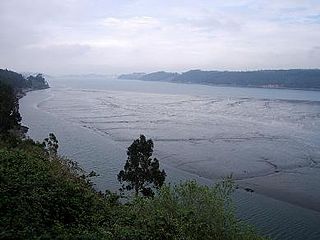
The Eo is a river, 91 kilometres (57 mi) long, in northwestern Spain. Its estuary forms the boundary between the regions of Galicia and Asturias. The river is known for its salmon fishing.

A Pontenova is a municipality in the province of Lugo, in the autonomous community of Galicia, Spain. It belongs to the comarca of A Mariña Oriental. It has a population of 3199 and an area of 136 km².

Fernando Villapol Parapar is a museum curator and art critic, most famous as a contemporary Galician sculptor. He currently lives and works in the town of Bretoña (Lugo) located in Galicia. He is also the founder of the Ethnographic-Pedagogic Museum in Bretoña. He studied at the College of Applied Arts in Lugo, Spain, although can be considered an autodidact, attributing most of his knowledge and acquired skills through his self-funded travels and investigations of sculpture across the globe.

As Veigas is one of four parishes in Taramundi, a municipality within the province and autonomous community of Asturias, in northern Spain.
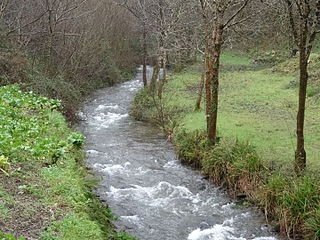
The Turía is a small river in Galicia, Spain. It is 9 kilometres (6 mi) long, and its mouth is at an elevation of 250 metres (820 ft) above the sea. It rises in the town of Taramundi (Asturias) and drains into the Eo River in the town of A Pontenova.
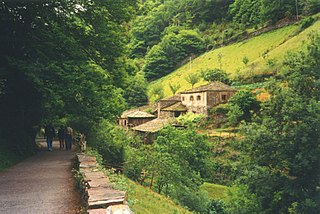
The Turia Valley is a small valley on the western border of the Cantabrian Mountains in the northwest of Spain which is close to beaches and is divided by two autonomous communities: Asturias and Galicia. It consists of an area of 90 km2, 3,910 inhabitants and is 200 m above sea level. The two main towns are A Pontenova (Galicia) and Taramundi (Asturias).

Mazonovo is a former town and now a museum in the municipality of Taramundi, Asturias, Spain. It is located between the Cabreira River and the Turía River, southeast of the town of Taramundi, northwest of Veigas, and 183 km (114 mi) from Oviedo, the capital of Asturias. According to the census of 2005, the population is four people.
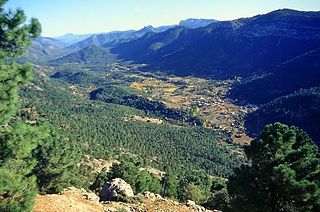
Sierras de Cazorla, Segura y Las Villas Natural Park is a natural park in the eastern and northeastern part of the province of Jaén, Spain, established in 1986. With an area of 2,099.2 square kilometres (810.5 sq mi), it is the largest protected area in Spain and the second largest in Europe. It was declared a biosphere reserve by UNESCO in 1983 and also a Special Protection Area for migratory birds in 1988.

The Galician Massif is a system of mountain ranges in the northwestern corner of the Iberian Peninsula. It is located in Galicia with its southeastern end reaching into the provinces of Zamora and León of Castile and León. Its highest point is Pena Trevinca at 2,127 metres (6,978 ft). Another important peak is Cabeza de Manzaneda.
